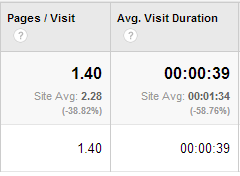Want to find out how to get more blog traffic? Read on.
Read on for a real-life example of how one lowly blog page is helping transform a small London company.
UWP have a client who has an extensive website with various pages. It is, of course, of no use if she isn’t driving people to it in the first place. She realises this but unfortunately her competitors have probably all worked out the same thing so this hardly sets her apart.
However, by studying people’s behaviour on her site and tweaking things accordingly we’ve helped her steal a march on her rivals.
Google Analytics helps you dissect the user experience so you can constantly improve your site. Without it, tweaking your website is like decorating your house in the dark – it might work but I wouldn’t bank on it.

John told Foxtons he wouldn’t pay a penny over a million – even if it was the most sought-after studio flat in Hartlepool
How improving web content helps your business – here’s proof
Hundreds of people go on our client’s website every month – that’s not a huge number but a lot of them turn into paying customers and it is only a small business so this keeps things ticking over nicely.
However, some pages are far more popular than others. One page in particular has clearly captured the public’s imagination.
We weren’t expecting it but that page – a blog page – has had far more hits than any other on her website barring the home page. It was probably being seen six or seven times more than we expected.
The page wasn’t doing badly after people reached it – the average reader stayed on it for 39 seconds which is not to be sniffed at in this day and age.
However, having realised how important the page is, we wanted to try and increase the average stay. And, being a greedy bunch of so-and-sos, we ideally wanted to get even more people to the page in the first place.
We got to work, starting by analysing the search terms that people keyed in to reach it – giving us a better idea of exactly what they were looking for.
We then made the page more search-engine friendly and improved the quality of the writing in a bid to keep readers interested for longer.
Let’s cut to the chase: That key figure of 39 seconds rose to a whopping 65 seconds overnight. And stayed there.
But that’s not all. We also got far more people to visit the page in the first place. And – perhaps best of all – the average amount of pages users visited on her site after reading that blog more than doubled. Again, all of this happened overnight.
This final fact suggests to us that, having read the improved blog, more people than before became interested in our client and want to find out more about her company.
That’s all well and good but it’s no use without the only stat that matters so drum roll please: She reckons she’s getting over 20% more business as a result of this one blog page.
It’s impossible to prove this stat beyond doubt but she makes a point of asking new clients why they have approached her so she’s pretty confident.
Not bad for a one-off spend of barely £100. That’s only the start though – there’s a bigger picture.

Before

After!
The long-term benefits of having great content on your site
Search engines reward websites that are regularly updated so having fresh, new content is a good thing in itself.
However, the quality of that content is priceless because getting people to stay on your site for longer is pivotal in the eyes of search engines like Google in the long run. Which means sites with the best content end up higher up the rankings on their results pages.
Gone are the days when you could trick Google into thinking your website is relevant because you cram it full of certain words and phrases.
Nowadays, if you want to rank high on search engine results pages you need to prove you can attract users to your site, keep them there and keep them browsing through as many pages as possible.
Hence a few hours a month analysing how people use your site and tweaking it accordingly can make the world of difference.
You might well benefit overnight, like our client. But that’s nothing compared to what it could do for you in the long run.
Like I said the devil is in the detail. You’ve just got to know what to look for.
